Understanding User Acquisition in Mobile UA Gaming
Paid user acquisition costs have surged, with iOS CPI forecast to average $4.70, while Android CPI is $3.40. Despite these costs, over 300,000 advertisers are expected to compete for user attention this year.
That pressure only grows as you chase installs without a clear plan. You end up testing random channels, tweaking bids on the fly, and still wondering why your costs continue to climb while engagement remains flat. Every dollar you spend without direction is a dollar pulled from features, live ops, or rewards that actually keep players coming back.
There is a better way. By focusing on a tested UA gaming framework, you’ll know exactly where to invest, how to measure success, and which tactics drive quality installs. You’ll cut wasted spend, boost return on ad dollars, and attract players who stick around for days, weeks, even months.
In this blog, you’ll walk through what “UA gaming” truly means today, compare paid and organic paths, explore top channels and core tactics, and map out the exact steps to build a growth engine that scales. By the end, you’ll have a clear roadmap for bringing in high‑value players and making every campaign dollar count.
What Is User Acquisition (UA)?
User acquisition in mobile gaming is the process you use to bring new players into your game through both paid ads (like social or search ads) and organic channels (like app store optimization or social shares). You combine these approaches to reach as many potential players as possible and keep your campaign costs under control.
Why UA Gaming Is Essential in 2025
Now, here is why focusing on UA gaming matters this year:
With over 700,000 mobile games on Google Play and the App Store combined, cutting through the noise requires a data-driven UA framework.
Bringing in higher‑quality players means better lifetime value (LTV) and stronger return on ad spend (ROAS). Brand budgets and e-commerce ad dollars have driven a 10–20% increase in LTV for many games, resulting in a lift in the average revenue per daily active user across the board.
Reward‑based campaigns now outperform traditional channels for 82% of developers, delivering better install rates and deeper engagement. Planning to incorporate offers, in‑game rewards, or playable ads can give your UA gaming efforts a clear edge.
That’s why a focused UA gaming plan is your best bet for cutting through competition, maximizing monetization, and growing your player base in 2025.
There are two core ways to drive user growth: paid and organic. Each has its strengths and challenges. Let’s break them down.
Also Read: Creating pLTV Framework for Mobile Games: How to Improve User Acquisition and Maximize ROAS
Paid vs Organic User Acquisition in Mobile Gaming
With paid UA, you tap into channels that enable you to reach a large number of potential players quickly. Key options include:
1. Paid UA
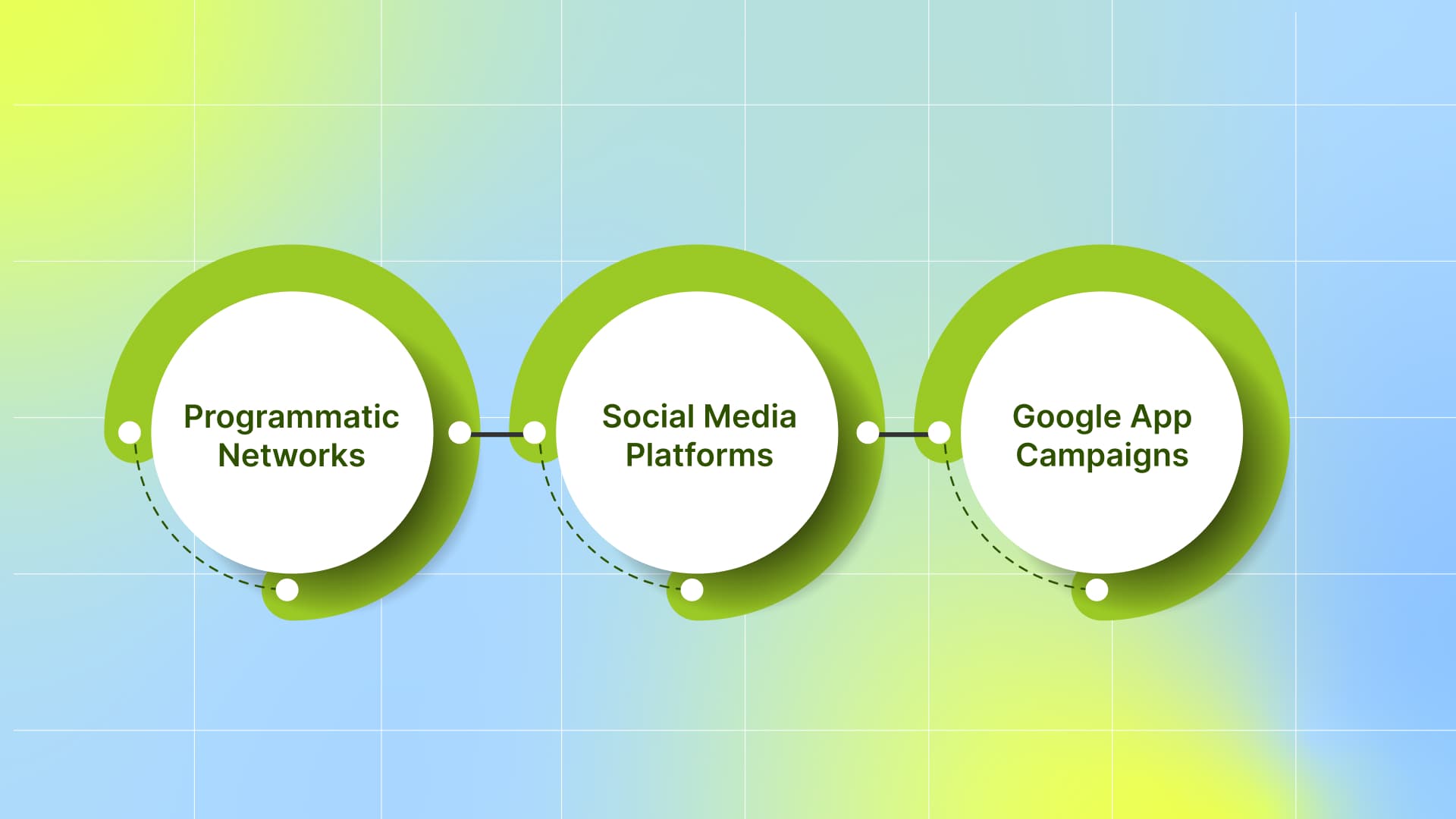
Programmatic Networks: Platforms like Unity Ads, Smadex, AdColony, and ironSource enable you to serve ads directly within other mobile games. These networks give you access to engaged users in real gaming environments.
Social Media Platforms: You can run ads on Meta’s Audience Network and TikTok for Business to reach users through short videos, playable ads, or creative visuals. These platforms support performance tracking and creative testing to improve install quality.
Google App Campaigns: Google Ads’ App Campaigns (previously called Universal App Campaigns) place your game across Google Play, YouTube, Search, and Display without manual targeting. You upload your assets, set a budget and goal, and the system takes care of the rest.
Pros:
Instant scale across multiple networks: Google App Campaigns provide access to a vast user base across various Google properties.
Automated optimization for installs or in-app events: The system utilizes machine learning to optimize ad performance for desired outcomes.
Cons:
Higher cost per install (CPI): In North America, the average CPI for gaming apps hovers around $5.28.
Need for regular creative testing: To maintain optimal performance, it's essential to test and refine ad creatives continuously.
2. Organic UA
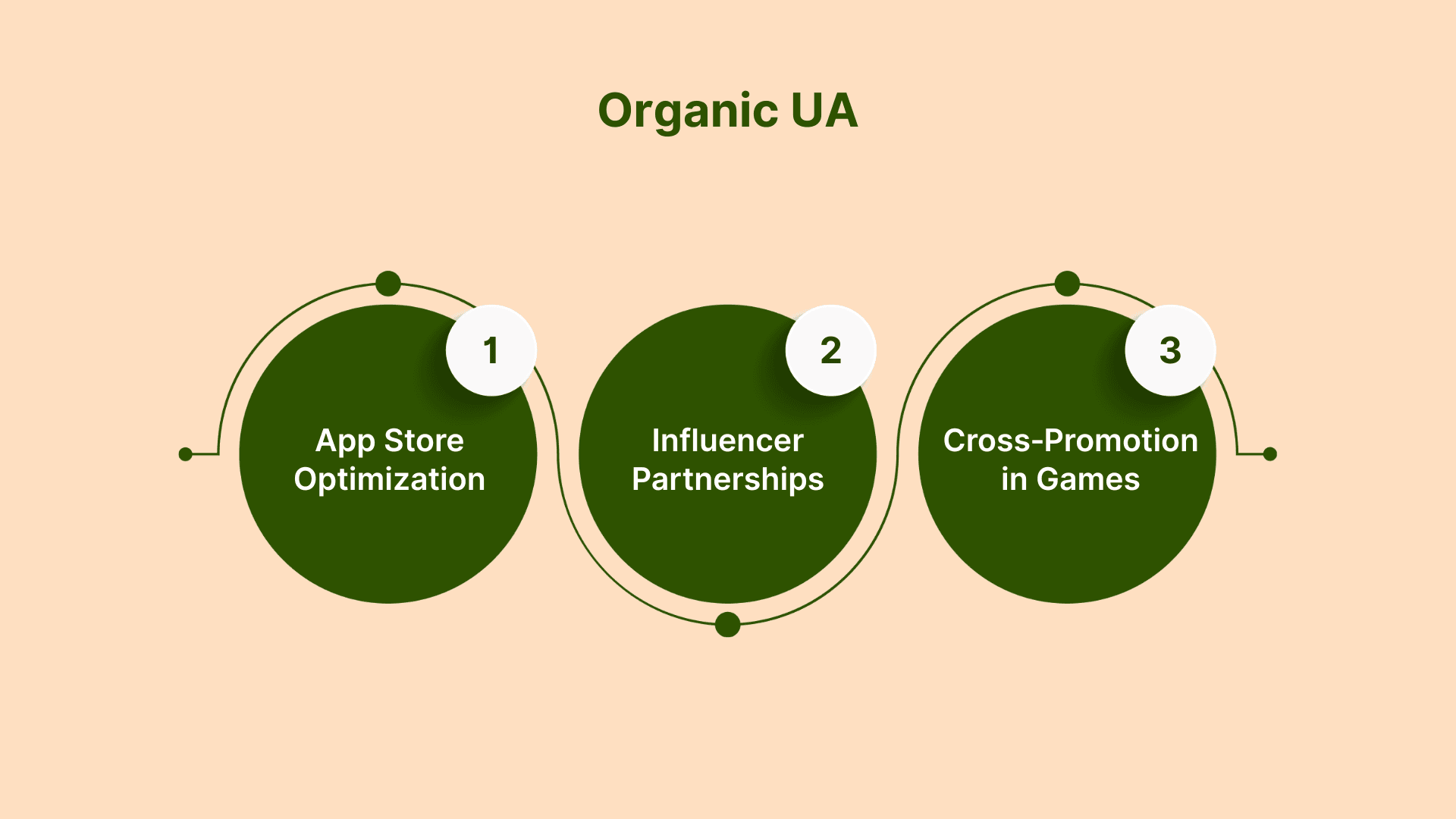
Organic UA grows your audience over time by improving discoverability and leveraging partnerships:
App Store Optimization (ASO):
Improve your app’s visibility by optimizing its title, keywords, icon, screenshots, and description. In 2025, ASO best practices also include:
Localizing metadata for top-performing regions
A/B testing store listings to find what converts best
Updating creatives regularly to reflect trends or events
Using in-app events and promotional content to stay visible in featured placements
Preparing for voice search and leveraging AI-based keyword tools
These changes help improve search rankings and increase conversion rates in both the App Store and Google Play.
Influencer Partnerships:
Working with gaming creators remains a strong organic strategy in 2025. Authentic gameplay showcases and reviews often drive higher intent installs. Long‑term influencer relationships are proving to be especially effective, with top creators generating over $1.1 million in annual campaign value.
Cross‑Promotion in Your Own Games:
If you have more than one title, promoting your new release inside existing games can be a cost-free way to reach players who already know your brand. In-game placements, such as pop-ups, banners, or rewarded ads, help boost installs without requiring additional media spend.
Pros:
Lower direct cost per install: You’re not bidding on ad inventory, so each new install comes without a direct fee.
Builds long-term, compounding growth: Improved rankings, word-of-mouth, and influencer content continue to drive installs over weeks or months.
Leverages store and audience trust for better retention: Good ratings, in‑app events, and peer recommendations help you keep players engaged and returning.
Cons:
Slower growth curve: Organic tactics take time to show impact, you may only see a gradual rise in installs instead of an immediate spike.
Depends on strong creative and engagement signals: If your app assets, ratings, or retention metrics aren’t solid, your visibility gains will stall.
Requires ongoing optimization: You must continuously update metadata, creatives, and partnerships to maintain momentum.
Knowing what organic UA does well and where it’s slower helps you plan better. You can focus on steady growth and use paid ads when you need faster results.
Once you’ve chosen your mix of paid and organic, the next step is picking the right channels to reach your players.
Also Read: Creative Optimization in 2025: Dynamic Creative Optimization (DCO) Playbook for Mobile UA
Top User Acquisition Channels for Mobile Gaming
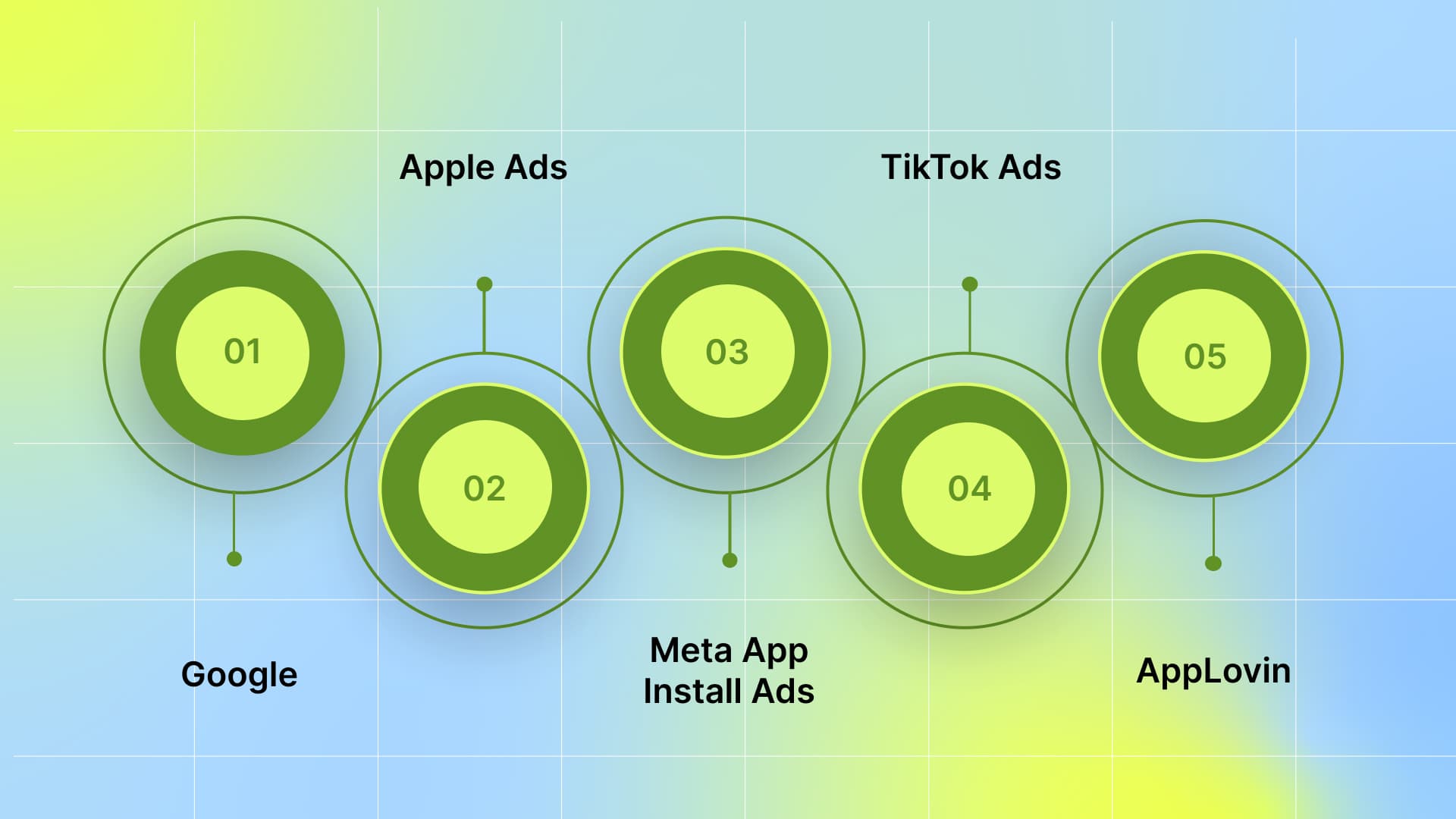
Below are five proven channels you can use in 2025. Each channel enables you to reach new users, optimize costs, and increase installs. Try a mix, measure performance, and scale what works best for you:
1. Google
Google App Campaigns (formerly known as Universal App Campaigns) utilize automation to display your ads across Search, YouTube, Google Play, Display, AdMob, and more. You set your goal installs or in‑app events, then supply creative assets and a target cost per install. Google’s machine learning handles bidding, targeting, and placement to meet your goal at the lowest cost.
Action Steps:
Choose OPTIMIZE_INSTALLS for pure install volume or OPTIMIZE_IN_APP_CONVERSIONS to drive specific actions.
Provide a diverse range of text, image, and video assets for the algorithm to test.
Link Google Analytics for Firebase for richer conversion data and bid automation.
2. Apple Ads
Apple Ads (formerly Apple Search Ads) places your game at the top of App Store search results and Search Tab. You can run Basic campaigns for fast setup or Advanced for full control over keywords, bids, and audience targeting. Custom Product Pages (CPPs) enable you to display tailored pages for different ad groups, potentially boosting conversion rates by up to 8% for games.
Action Steps:
Start with Basic to test keyword demand, then upgrade to Advanced for keyword management and negative keywords.
Create up to 35 CPPs highlighting features or events that match your ad’s message.
Use broad match for discovery and exact match for high‑intent keywords.
3. Meta App Install Ads
On Facebook and Instagram, use the APP_INSTALLS objective in Ads Manager or via the Marketing API. You can target by device, demographic, interest, or custom audience (e.g., people who engaged with your content). Video ads often deliver higher install rates when paired with clear calls to action.
Action Steps:
Select APP_INSTALLS as your campaign objective and set up the Meta SDK for tracking.
Test video creatives with “Install Now” CTAs and deep links into your game.
Retarget people who installed but didn’t complete onboarding to boost Day‑1 retention.
4. TikTok Ads
TikTok lets you run App Install campaigns under the Consideration objective. It's automated creative optimization mixes your assets to find top performers. You can choose In‑Feed, Pangle, or Spark Ads (using user‑generated content). Playable Ads offer interactive previews of your game, often lifting installs and Day‑1 engagement.
Action Steps:
Set your campaign objective to App Installs and enable Automated Creative Optimization.
Include at least one playable ad to let users sample your game.
Target by OS, device price tier, and interests to find high‑value players.
5. AppLovin (and Other DSPs)
When you want to reach high‑value players at scale, demand‑side platforms (DSPs) are a top choice. DSPs utilize AI to place your ads in real-time across multiple apps, helping you achieve your target cost per install (CPI) and maximize return on ad spend (ROAS).
AppLovin’s ad tech business drove its advertising revenue up 71% to $1.16 billion in Q1 2025, underlining the strength of its Axon AI optimization across mobile‑game inventory. Beyond AppLovin, these DSPs are top choices for mobile gaming UA in 2025:
IronSource LevelPlay: connects your ads to premium in-app inventory on over 2 billion devices. It offers real‑time bidding, dynamic floor prices, and mediation tools to balance monetization and UA goals.
Unity Ads: Unity Ads offers Performance, Engagement, and Scale campaigns across its network of apps and games. You control bids, budgets, and targeting, while Unity’s ML optimizes for installs, retention, or ROAS. Formats include rewarded video, playables, and end‑cards. Over 70 of the top 100 grossing mobile games trust Unity for growth.
Action Steps:
Set a clear CPI goal. Input your target CPI into each DSP and let its AI bid toward that number across publishers.
Monitor performance frequently. Check install rates, CPI, and early‑retention metrics at least twice a week.
Rotate video or playable ads every 2–4 weeks to prevent ad fatigue and maintain high engagement.
Blend programmatic with direct buys. Use DSPs for scale, then supplement with direct publisher deals on your top-performing apps.
By combining AppLovin, ironSource LevelPlay, Unity Ads, and similar DSPs, you’ll cover more inventory, optimize bids with machine learning, and grow your player base efficiently in 2025.
Picking channels is just the start. Let’s examine the key strategies that help convert installs into long-term success.
Core UA Gaming Strategies for Acquiring Users
To bring more players into your game this year, try these five detailed tactics. Each one gives you clear steps you can follow today.
1. Configure Apple’s AdAttributionKit for Precise Attribution
Set up AdAttributionKit (AAK) in your iOS build to obtain detailed, privacy-safe data on installs and re-engagements. In iOS 18.4+, you can:
Use overlapping re‑engagement windows. Tag each ad type to measure multiple in‑app actions (installs, opens) without merging them into a single signal.
Customize attribution windows. Define view‑through and click‑through windows per network in your Info.plist to match each campaign’s goals.
Enable geo‑level postbacks. Get country codes in postbacks to see where installs happen, without sacrificing conversion‑value bits.
Validate in developer mode. Use the built-in testing tool in Settings to confirm your setup with live debug postbacks.
2. Leverage Google App Campaigns’ Multi‑Channel Automation
Let Google’s machine learning run your install ads across Search, YouTube, Display, Play, and partner apps. To make it work for you:
- Set advertising_channel_type to MULTI_CHANNEL.That unlocks all surfaces in one campaign.
Provide varied creative assets. Upload up to five headlines, five descriptions, plus square, landscape, and portrait images, and 10–30 sec videos.
Link Firebase for conversion tracking. Pass in‑app events and revenue values so you can bid on installs (Target CPI) or on value (Target ROAS).
Choose your bid strategy. Start by maximizing conversions to gather volume, then shift to Targeting CPI or ROAS once you have sufficient data.
3. Simplify Campaigns with Meta’s Advantage+ App Campaigns
In Meta Ads Manager, use Advantage+ to reduce manual setup and unlock AI‑driven delivery:
One campaign, one ad set. Upload up to 50 images, videos, or playable ads along with up to five texts and headlines.
Automatic placements. Let Meta choose placements across Facebook, Instagram, Messenger, and Audience Network.
Optimize for in‑app events. Ensure that you send App Events (e.g., purchases, registrations) via the Facebook SDK.
Enable SKAdNetwork attribution. If you’re targeting iOS 14+ devices, toggle to is_skadnetwork_attribution=true receive SKAN postbacks.
4. Boost Visibility with Apple Search Ads
Capture high‑intent players searching in the App Store:
Bid on branded and category terms. Test both to find the highest‑converting keywords.
Use CPT bidding. Set cost‑per-tap targets that align with your target CPI.
Monitor via AdAttributionKit. Since Apple Ads now appear in AAK, compare your Search Ads performance against other channels in one dashboard.
5. Drive Smarter Spend with Predictive LTV and Cohorts
Focus on users who will spend more or stick around:
Run an LTV analysis. Use Google’s LTV Calculator to set realistic CPI and budget targets.
Segment by early behavior. Track Day 1, Day 7, and Day 30 retention in Firebase dashboards to spot high‑value audiences.
Allocate budget dynamically. Shift spend toward campaigns and audiences that show above‑average LTV, not just low CPI.
By setting up precise attribution, automating multi‑channel buys, simplifying creative delivery, capturing high‑intent App Store traffic, and funding the players who matter most, you’ll build a UA engine that scales in 2025 and beyond.
In addition to those tactics, a few best practices can help you maximize the effectiveness of your campaigns.
Also Read: Ultimate Guide to Creative Testing for Mobile Game User Acquisition
High-Performing UA Gaming Best Practices
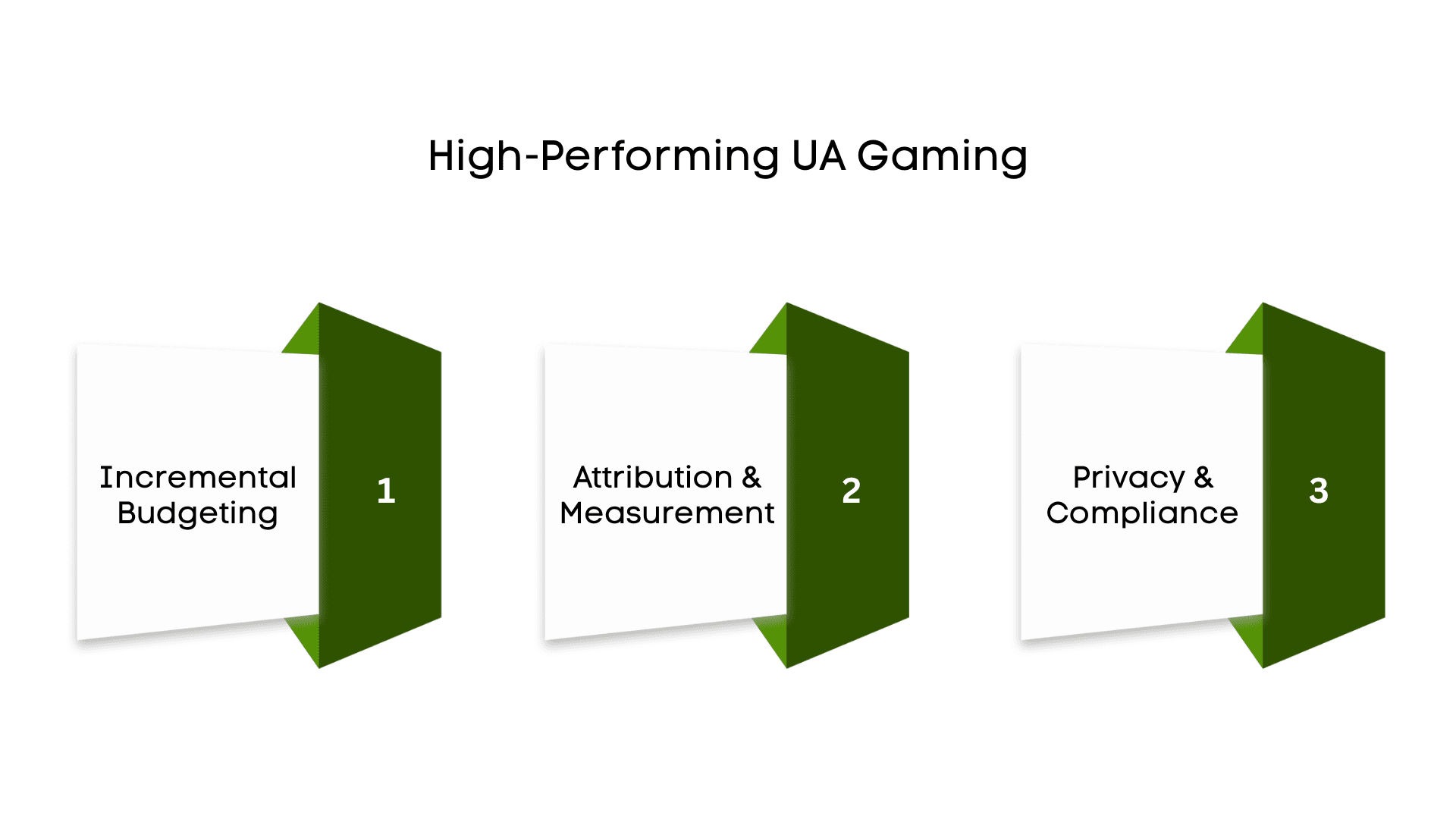
When you’re ready to boost your game’s installs, focus on three key areas:
1. Incremental Budgeting: It helps allocate funds efficiently by scaling budgets on proven creatives, reducing risk, and maximizing ROI. Utilize budget scheduling tools, such as Meta’s Budget Scheduling feature, to plan small, regular increases for your top-performing creatives. This approach helps you ramp up winners without overspending on underperforming ads.
2. Attribution & Measurement: Choose a trusted mobile measurement partner (MMP), such as AppsFlyer or Adjust, to link installs and post-install events back to your campaigns. Implement fraud filtering to block fake installs, and set lookback windows that match your game’s pace, shorter for hyper‑casual titles, longer for mid‑core experiences.
3. Privacy & Compliance: Respect user choices under Apple’s App Tracking Transparency (ATT) and handle IDFA opt‑outs properly. This ensures compliance with privacy laws while maintaining accurate attribution and minimizing data loss in performance tracking. Follow regional privacy laws (e.g., GDPR, COPPA) to maintain players’ trust and avoid fines, such as the recent antitrust scrutiny over AT&T in France.
Keep these best practices in mind and watch your UA efforts deliver stronger results.
UA is constantly shifting. Here’s what’s coming next and where smart teams are focusing their efforts in 2025.
Also Read: Cracking Creatives: What Lands of Jail Can Teach UA-Teams About High-ROAS Creatives
Future Trends in UA Gaming in 2025
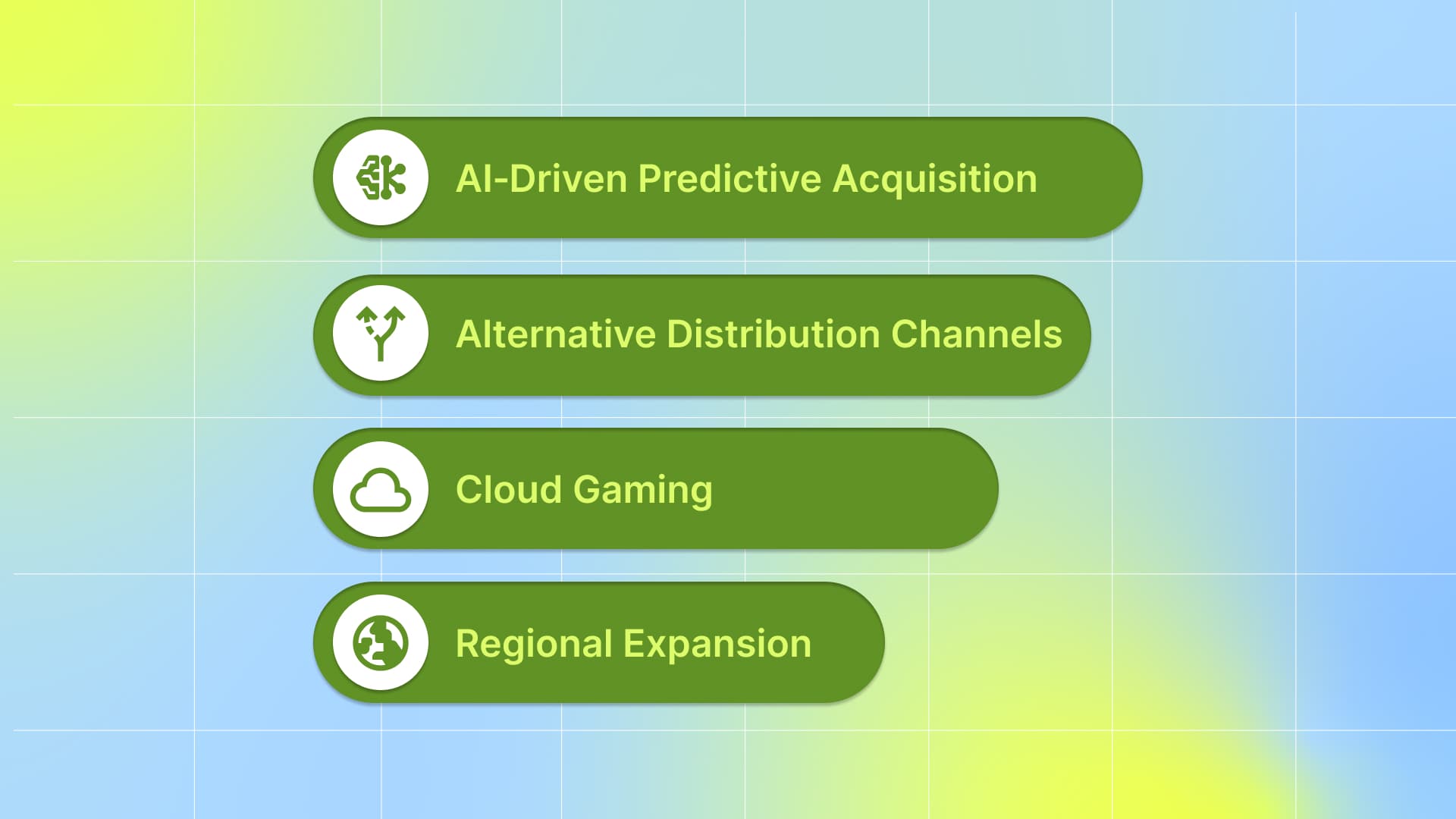
Looking ahead, these trends will shape how you find new players:
1. AI‑Driven Predictive Acquisition: Machine learning can predict how valuable a user might be over time and help set better bidding strategies before auctions start, making your ad spend more efficient. Platforms offering pre-bid intelligence help you acquire high-quality users at scale.
2. Alternative Distribution Channels: Explore app stores beyond Apple and Google, as well as direct-to-consumer web shops. These channels cut out steep platform fees and give you more control over promotions and pricing.
3. Cloud Gaming & Streaming Ads: In-stream ads within cloud platforms, such as Xbox Cloud Gaming, are opening new touchpoints. You can reach players who stream games on PCs, consoles, and mobile devices without requiring an install first.
4. Regional Expansion: Tier 1 markets are becoming increasingly expensive. Shift the budget to lower-CPI regions, such as Southeast Asia and Latin America, where mobile game growth is strong and costs remain competitive.
By exploring these trends now, you’ll be ready for the next wave of UA innovation.
Pulling all this together, here’s what you need to remember as you build and scale your UA efforts this year.
Also Read: Unlocking the Full Potential of Mobile User Acquisition (UA) with AI
Conclusion
Successful mobile UA in 2025 depends on combining both paid and organic strategies. Paid channels, such as Google App Campaigns, help scale quickly, while organic methods, including ASO and influencer partnerships, drive long-term value. Automation and creative variety are also important.
Testing different ad formats across DSPs, utilizing playable ads, and regularly updating creatives helps keep campaigns effective and within budget. Accurate measurement, with clear attribution, user cohorts, and LTV predictions, supports smarter budget planning and helps focus on users who matter most. New trends, such as AI-based bidding, alternative app stores, and cloud-streaming ads, offer growth opportunities for teams that move early.
Segwise directly addresses the essential challenges highlighted in the blog by providing targeted tools for creative execution and campaign oversight:
Automated creative analytics: Segwise’s Creative Analytics AI Agent automatically tags elements like backgrounds, calls-to-action, characters, and emotional hooks across images, video, and playable ads.
Early fatigue detection: The platform identifies signals of creative exhaustion, allowing you to refresh underperforming assets before they impact install rates or ROAS.
No-engineer integration: With plug-and-play, no-code setup and SOC-certified data security, UA and creative teams can deploy immediately and access results fast.
Ready to streamline your UA workflow and elevate campaign ROI with AI-driven insights? Start a 14‑day free trial today.
FAQs
How do I calculate the return on investment (ROI) for a UA campaign? Comparing the total revenue generated by new players against the total ad spend, using metrics such as return on ad spend (ROAS) and lifetime value (LTV), provides a clear picture of profitability.
What role do creative assets play in improving UA performance? High‑quality visuals, videos, and playable ads help users understand your game upfront, leading to better install rates and more engaged players.
Are referral programs worth implementing for mobile games? Yes, rewarding current players for inviting friends can drive installs with higher retention, since people tend to trust game recommendations from friends.
How can community engagement boost user acquisition? Actively participating in gaming forums, Discord servers, or subreddits builds trust and spreads word‑of‑mouth recommendations that convert into organic installs.
What’s the impact of dynamic CPI bidding on campaign scaling? Adjusting cost-per-install bids in real-time lets you stay competitive when costs fluctuate, ensuring you balance budget efficiency with user quality.

Comments
Your comment has been submitted successfully!